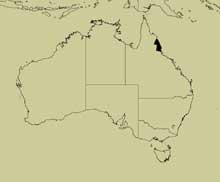Synonyms
Sticholotis redimita Weise, 1923: 136
Diagnosis
This species is easily distinguished from all other Australian Sticholotis by the reddish or yellowish elytra bearing dark fasciae and irregular spots
Description
Length 4.1-4.8 mm. Winged; form rounded, moderately convex with elytral and pronotal margins moderately explanate, entirely visible from above. Surfaces between pronotal and elytral punctures highly polished, surfaces between head punctures distinctly reticulate and feebly shiny; dorsum apparently glabrous.
Dorsal color pattern consisting of black or dark-brown spots and fasciae on orange or reddish background. Pronotum usually entirely black with small orange marks along the anterior corners, the markings sometimes extend along the lateral margins or expand to occupy most of the lateral portions of pronotum, limiting black area to the central spot. Elytral suture and scutellum usually brown. Elytra typically with narrow yellow lateral margin, central dark spot and irregularly shaped dark submarginal ring that is broadly incomplete anteriorly. Ground color of ventral surface golden brown to dark brown with meso- and metaventrites slightly darker than appendages or abdomen.
Head flat at middle, punctuate, sometimes with short sparse setae near clypeus. Clypeus weakly arcuate anteriorly, faintly upturned at anterior edge. Eyes large, rather coarsely facetted, dorsally separated by about thrice width of eye.
Male
Head entirely yellowish or brown; labrum, mouthparts and antennae yellow. Male genitalia. Tegmen 1.1 times and median lobe 1.1-1.3 times as long as abdomen; each paramere with single moderately long seta at apex.
Female
Differs from male in having most of the head and often underside of the body dark brown to almost black. In the darkest forms only anterior margin of clypeus and labrum are brown; in very dark forms on underside mesepimeron is always distinctly lighter than middle of the thoracic ventrites. Spermatheca not sclerotised.
Variation
Elytral ground color varying from yellowish to almost reddish. Elytral submarginal ring is very variable, typically irregular in shape, incomplete anteriorly and well separated from the lateral margins of elytra but sometimes the lateral margin is very narrow and the black submarginal ring forms entire circle; in rare cases the submarginal ring is reduced to a black posterior maculae. Venter with more or less extensive areas of dark brown to almost black extending to large portion of abdomen.
 Distribution and Biology
Distribution and Biology
Found in costal regions northern Queensland. Adults have been collected on vegetation and probably feed on scale insects. The larva is unknown. Click on map for larger version (use the bowser 'back arrow' to return to this page).
Species References
Slipinski, A. 2004. Revision of the Australian Coccinellidae (Coleoptera). Part 2. Tribe Sticholotidini. Annales Zoologici, 54: 389-402.
Weise, J. 1923. Results of Dr. E. Mjöberg's Swedish Scientific Expedition to Australia 1910-1913. 31. Chrysomeliden und Coccinelliden aus Queensland. Arkiv för Zoologi, 15: 1-150.
[ Top ]
